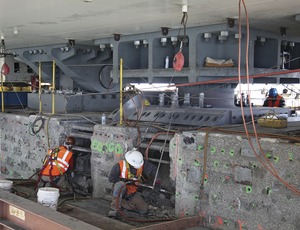
Seismic anchor rods used for the $6.4-billion San Francisco-Oakland Bay Bridge are once again under scrutiny. Inspectors' discovery last month of stripped threads, loss of protective coatings and micro-indicators in three galvanized-steel units—installed in 2007 at the base of the bridge's 525-ft-tall east self-anchored suspension span (SAS) tower—have triggered a new probe.
Although the investigation is ongoing, Caltrans believes the presence of water in the 3- to 4-in.-dia, 26-ft-long rods' steel casings may have contributed to the problem. One rod fractured, with characteristics typically associated with hydrogen embrittlement, a condition that arises when nonuniform metal is exposed to excess hydrogen and tension. Similar fractures occurred in 2013, when 32 of 96 galvanized-steel rods used for the east tower's shear keys failed during tightening after being exposed to salt water.
The shear-key rods were fabricated by Dyson Corp., Paynesville, Ohio, while those for the SAS tower were manufactured by another U.S. firm, Pelham, Ala.-based Vulcan Steel Products.
Though Caltrans Chief Engineer Brian Mulroney is hesitant to say definitely embrittlement is the culprit for the failure of the tower rod, he notes that the "multimodal failure is interesting and something we need to learn more about."
Caltrans has also found that lower sections of nearly all of the 424 rods installed at the base of the SAS tower have been immersed in as much as 12 in. of water. Forensics reveal materials with characteristics consistent with diluted salt water from the bay, indicating more than one source. Follow-up tests revealed that 151 of the rods' protective sleeves were not fully grouted. That work, performed in 2011, was overseen by the SAS tower's construction team, a joint venture of American Bridge and Fluor.
Also under study as a potential source of water intrusion are cracks in the tension zone of the concrete-and-steel foundation cap, which was constructed in 2007-08 by the joint venture of Kiewit/FCI/Manson.
While the anchor rods are required to stabilize the SAS tower during the most severe seismic events, Caltrans verified the rods' integrity in May by performing a seismic-proof "pull test" using a hydraulic jack. Of the 408 rods that could be accessed, only one failed. Initial analysis found stripped and distorted threads, but no indication of fracture.
Caltrans has appointed a 15-member multidisciplinary panel of construction engineers, material scientists, metallurgists, bolt specialists, and other experts. They are charged with developing a testing plan and protocol to help the agency determine alternatives for rectifying deficiencies found in the rods and their surrounding structures. The plan is to be presented in September to the Toll Bridge Program Oversight Committee, which provides project oversight and project control for the seismic retrofit of California's three state-owned toll structures.
"I'm particularly interested in the measurements of the thread sizes and stress corrosion tests," Mulroney says. "We're also hoping to learn more about the rods' inner granular structure, which will tell us how well they perform under load."
Unlike the shear-key anchor rods, which could not be removed and were retrofitted with custom-made steel saddles with hundreds of post-tension wires at a cost of $25 million, the units at the tower base could be repaired, modified or replaced entirely. Other potential corrective measures include removing grout from the rod casings and extracting the water by pumping grease from the bottom up, then regrouting the sleeves with a higher-strength material. Reducing tension on the rods is also an option.
"While the rods are not performing as they were designed, I'm confident that if an earthquake occurred today, the bridge would remain safe," Mulroney says. "The challenge for us is to find out the exact causes for the failures and discrepancies using the best science. We want to be as thorough and meticulous as possible, so that we can deliver a bridge that will last 150 years."


Post a comment to this article
Report Abusive Comment